DIY digestive tea offers a natural solution to common stomach issues. You'll find relief from bloating, gas, and indigestion by brewing your own blend using herbs like peppermint, ginger, and fennel. These ingredients soothe your digestive tract, reduce inflammation, and promote better nutrient absorption. To make your tea, simply steep your chosen herbs in hot water for 5-10 minutes. You can customize flavors and adjust strengths to suit your taste. By incorporating this homemade remedy into your daily routine, you'll support your digestive health without relying on over-the-counter medications. Discover how easy it is to harness nature's power for your well-being.
Understanding Digestive Health
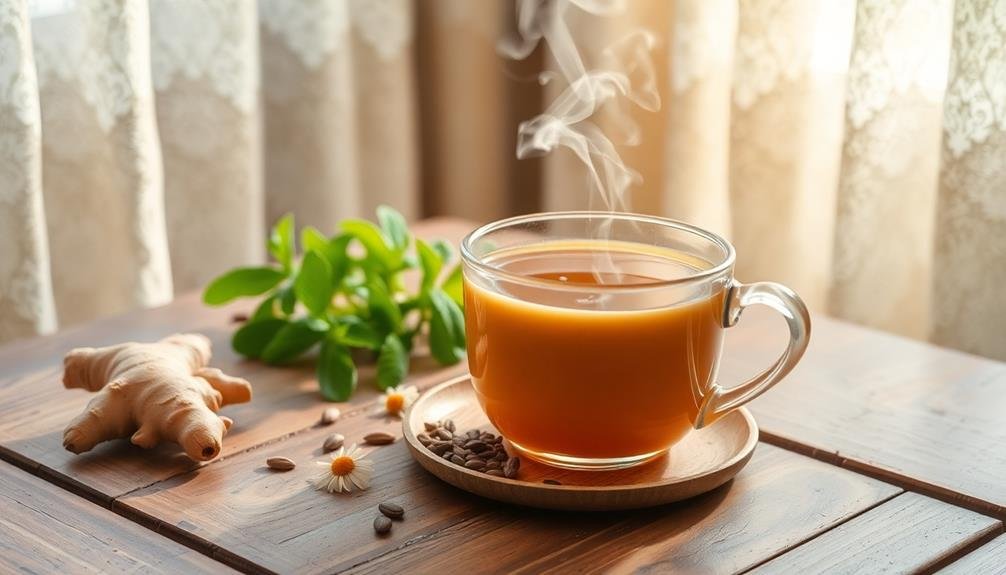
In light of the importance of digestive health, it's crucial to understand how your digestive system works. Your digestive system is a complex network of organs that break down food, absorb nutrients, and eliminate waste.
It starts with your mouth, where chewing and saliva begin the process of breaking down food. As food travels through your esophagus to your stomach, it's further broken down by stomach acid and enzymes.
The small intestine is where most nutrient absorption occurs, aided by bile from the liver and enzymes from the pancreas. Your large intestine then absorbs water and electrolytes, forming solid waste.
This intricate process can be disrupted by various factors, including diet, stress, and medical conditions. Common digestive issues include acid reflux, bloating, constipation, and irritable bowel syndrome.
Maintaining a healthy diet, staying hydrated, and managing stress can greatly improve your digestive health. Regular exercise also promotes better digestion by stimulating intestinal muscles.
Benefits of Herbal Teas
Herbal teas offer a wealth of benefits for digestive health and overall well-being. When you sip on these natural brews, you're not just enjoying a comforting drink; you're also providing your body with powerful plant-based compounds that can soothe and support your digestive system.
Many herbal teas contain ingredients known for their anti-inflammatory and antispasmodic properties, which can help alleviate common digestive issues like bloating, gas, and cramping. They're also rich in antioxidants, which protect your body's cells from damage and may reduce the risk of chronic diseases.
Here's what you can expect from regular consumption of herbal teas:
- Improved digestion and nutrient absorption
- Reduced inflammation in the gut
- Enhanced detoxification processes
- Strengthened immune system
Beyond digestive benefits, herbal teas can also promote relaxation, reduce stress, and improve sleep quality.
They're a caffeine-free alternative to coffee and traditional teas, making them suitable for consumption throughout the day without disrupting your sleep patterns.
Essential Herbs for Digestion

When crafting your digestive tea, you'll want to focus on three key herbs.
Peppermint acts as a soothing stomach soother, calming digestive discomfort.
Ginger serves as a powerful anti-inflammatory digestive aid, promoting overall gut health.
Fennel rounds out the trio by offering relief from gas and bloating, making it an essential component of your DIY blend.
Peppermint: Soothing Stomach Soother
Peppermint's cooling sensation offers immediate relief for an upset stomach. This popular herb contains menthol, which relaxes the muscles in your digestive tract, easing cramps and bloating.
You'll find that peppermint tea not only soothes your stomach but also invigorates your breath and helps reduce nausea.
To make peppermint tea, you'll need fresh or dried peppermint leaves. Steep a tablespoon of leaves in hot water for 5-10 minutes, then strain and enjoy. For added benefits, combine peppermint with other digestive herbs like ginger or fennel.
Here's what you can expect when drinking peppermint tea:
- A revitalizing, minty aroma that clears your sinuses
- A cool, tingling sensation in your mouth and throat
- A gradual easing of stomach discomfort
- Increased alertness and mental clarity
While peppermint is generally safe, it may worsen acid reflux in some people. If you have GERD or hiatal hernia, consult your doctor before using peppermint tea regularly.
For most people, however, peppermint tea is a delicious and effective natural remedy for digestive issues.
Ginger: Anti-Inflammatory Digestive Aid
Another powerful herb for digestive health is ginger. This root has been used for centuries to alleviate various digestive issues. Ginger's anti-inflammatory properties can help reduce bloating, gas, and stomach discomfort. It's also known to stimulate digestion and promote the production of digestive enzymes.
You can easily incorporate ginger into your DIY digestive tea. Fresh ginger root is ideal, but dried ginger powder can also be effective. Simply steep a few slices of fresh ginger or 1/4 teaspoon of powdered ginger in hot water for 5-10 minutes. For added benefits, combine ginger with other digestive herbs like peppermint or chamomile.
Here's a quick reference guide for using ginger in your digestive tea:
| Form | Amount | Steeping Time | Benefits |
|---|---|---|---|
| Fresh Root | 2-3 thin slices | 5-10 minutes | Strongest flavor, most potent |
| Dried Powder | 1/4 teaspoon | 3-5 minutes | Convenient, long shelf life |
| Tea Bags | 1 bag | 3-5 minutes | Pre-measured, easy to use |
| Crystallized | 1-2 pieces | 5-7 minutes | Sweet flavor, less potent |
Fennel: Gas and Bloating Relief
Fennel stands out as a remarkable herb for alleviating gas and bloating, making it an essential addition to your digestive tea arsenal. Its sweet, licorice-like flavor not only enhances the taste of your brew but also provides powerful digestive benefits.
Fennel seeds contain compounds that relax the muscles in your digestive tract, reducing cramping and discomfort. To harness fennel's gas-relieving properties, you'll want to steep 1-2 teaspoons of crushed fennel seeds in hot water for about 10 minutes.
You can also combine fennel with other digestive herbs like peppermint or chamomile for a more robust tea. Here's what you can expect when you incorporate fennel tea into your routine:
- Reduced bloating and flatulence
- Improved digestion and nutrient absorption
- Soothed stomach cramps and nausea
- Enhanced overall gut health
Fennel tea is particularly effective when consumed after meals or before bedtime. It's a safe, natural remedy that you can enjoy daily without worry.
Choosing Quality Ingredients
When making your DIY digestive tea, you'll need to choose between organic and conventional herbs, considering the potential benefits and costs of each.
You can opt for fresh herbs from your garden or dried ones, depending on availability and convenience.
It's essential to source your ingredients from reliable tea suppliers to guarantee quality and safety in your homemade blend.
Organic vs. Conventional Herbs
In light of the growing demand for natural remedies, choosing between organic and conventional herbs for your DIY digestive tea is essential. Organic herbs are grown without synthetic pesticides or fertilizers, offering a purer option for your tea. They're often more potent and flavorful, potentially requiring less for the same effect.
Conventional herbs, while more affordable, may contain residual chemicals that could affect your tea's quality and health benefits.
When deciding between organic and conventional herbs, consider these factors:
- Your budget and frequency of tea consumption
- Your sensitivity to synthetic chemicals
- The availability of organic options in your area
- The specific herbs you're using and their tendency to absorb pesticides
If you're using herbs known for high pesticide absorption, like mint or chamomile, prioritize organic options. For hardier herbs like fennel or ginger, conventional choices may suffice.
Remember, thoroughly washing conventional herbs can help reduce chemical residues. Ultimately, the choice between organic and conventional herbs depends on your personal priorities and health goals.
Whichever you choose, confirm you're sourcing from reputable suppliers to guarantee the best quality for your DIY digestive tea.
Fresh or Dried Options
Having chosen between organic and conventional herbs, you'll now face another key decision: whether to use fresh or dried ingredients in your DIY digestive tea. Both options have their merits, and your choice will depend on several factors.
Fresh herbs offer a vibrant flavor and higher concentration of volatile oils, which can enhance the tea's therapeutic properties. They're ideal if you have access to a herb garden or reliable source of fresh ingredients. However, fresh herbs have a shorter shelf life and may not be available year-round.
Dried herbs, on the other hand, are more convenient and have a longer shelf life. They're often more concentrated, meaning you'll need less to achieve the desired potency. Dried herbs are also easier to store and blend, making them a practical choice for regular tea drinkers.
When choosing dried herbs, look for ones that retain their color and aroma. Avoid herbs that appear dusty or have a musty smell.
If opting for fresh herbs, select those with vibrant colors and no signs of wilting or discoloration.
Ultimately, the choice between fresh and dried herbs will depend on your personal preferences, availability, and intended use of your DIY digestive tea.
Sourcing Reliable Tea Suppliers
Choosing quality ingredients from reliable suppliers is essential for crafting an effective DIY digestive tea. Look for reputable herb and tea shops, both online and in your local area. These specialized stores often provide high-quality, organic ingredients with detailed sourcing information.
When selecting suppliers, consider factors such as their reputation, customer reviews, and certifications.
For the best results, seek out suppliers who offer:
- Organic certification for their herbs and teas
- Detailed information on the origin and harvesting methods of their products
- Proper storage and packaging to maintain freshness
- Clear expiration dates and handling instructions
Don't hesitate to contact suppliers directly with questions about their sourcing practices or product quality. A reliable supplier should be transparent and willing to provide information about their ingredients.
If possible, visit local herb farms or tea gardens to source your ingredients directly. This allows you to see the growing conditions firsthand and build relationships with producers.
Basic Equipment Needed

Most DIY digestive tea recipes require only a few basic tools you likely already have in your kitchen. To get started, you'll need a kettle or pot for boiling water. A glass or ceramic teapot is ideal for steeping your tea, as it won't affect the flavor of your blend. If you don't have a teapot, a heat-resistant glass measuring cup will work just fine.
You'll also need a strainer or infuser to separate the tea leaves from the liquid. A fine-mesh strainer works well for loose leaf teas, while a tea ball or reusable cloth tea bag is perfect for smaller quantities. Don't forget a spoon for measuring and stirring your ingredients.
If you're planning to blend your own tea mixtures, invest in some airtight glass jars to store your herbs and finished blends. A small digital scale can be helpful for precise measurements, especially when following specific recipes.
Step-by-Step Blending Process
Once you've gathered your ingredients and equipment, the blending process for your digestive tea is straightforward.
Begin by measuring out your chosen herbs according to your recipe. Typically, you'll use one teaspoon of dried herbs per cup of water. Combine the herbs in your mixing bowl, ensuring they're evenly distributed.
Next, transfer the blend to your storage container. If you're using a glass jar, make sure it's completely dry to prevent mold growth. Label your container with the tea blend's name and date of creation. This step is essential for tracking freshness and remembering your favorite recipes.
When you're ready to brew, simply add one to two teaspoons of your blend to a tea infuser or bag. Steep in hot water for 5-10 minutes, depending on your desired strength.
Here's what you can expect from your homemade digestive tea:
- A fragrant aroma that fills your kitchen
- A soothing warmth as you sip
- A blend of flavors tailored to your taste
- A natural remedy for digestive discomfort
Steeping Techniques for Maximum Benefits

Once you've blended your digestive tea, it's essential to steep it correctly for maximum benefits.
You'll want to pay attention to the ideal water temperature, as different herbs may require different heat levels.
The steeping time matters greatly, and you should strain your tea for clarity before enjoying its digestive benefits.
Optimal Water Temperature
The ideal water temperature plays an essential role in extracting the full benefits from your DIY digestive tea. Different herbs and ingredients require specific temperatures to release their best flavor and therapeutic compounds. Generally, you'll want to avoid using boiling water, as it can scorch delicate leaves and destroy beneficial enzymes.
For most digestive teas, aim for water between 175°F and 195°F (79°C to 91°C). This range allows for proper extraction without damaging the herbs. To achieve this temperature without a thermometer, bring water to a boil, then let it cool for 1-2 minutes before pouring over your tea blend.
Here's a quick guide for common digestive tea ingredients:
- Green tea: 160°F – 180°F (71°C – 82°C)
- Peppermint and chamomile: 190°F – 200°F (88°C – 93°C)
- Ginger and fennel: 200°F – 212°F (93°C – 100°C)
- Licorice root: 212°F (100°C)
Steeping Time Matters
Steeping time is a crucial factor in crafting the perfect digestive tea. You'll want to pay close attention to how long you let your herbs infuse to extract the best benefits without over-steeping. Different herbs require varying steeping times to release their digestive-aiding compounds effectively.
Here's a quick guide to steeping times for common digestive tea ingredients:
| Herb | Steeping Time |
|---|---|
| Peppermint | 5-7 minutes |
| Ginger | 10-15 minutes |
| Chamomile | 3-5 minutes |
| Fennel Seeds | 7-10 minutes |
Remember, these are general guidelines. You can adjust the steeping time based on your preference for strength and flavor. If you're using a blend of herbs, steep for the longest recommended time among the ingredients.
To guarantee proper steeping, cover your cup or teapot to prevent the volatile oils from escaping. This will help retain the beneficial compounds and enhance the tea's digestive properties. Don't forget to strain the herbs before drinking to avoid any bitter flavors from over-steeping. With practice, you'll perfect your steeping technique and create a soothing, effective digestive tea tailored to your needs.
Straining for Clarity
Clarity in your digestive tea isn't just about flavor; it's vital for maximizing the benefits of your herbal infusion. Proper straining techniques guarantee you're getting the most out of your carefully selected ingredients while avoiding unwanted particles that can interfere with your tea's effectiveness.
To strain your digestive tea effectively, use a fine-mesh strainer or cheesecloth. Place it over your cup or teapot and slowly pour the steeped tea through. This process removes larger leaves, stems, and any sediment that might've settled during steeping.
For an even clearer brew, consider double-straining by repeating the process with a clean strainer.
Here's what you'll achieve with proper straining:
- A smoother, more enjoyable drinking experience
- Enhanced absorption of beneficial compounds
- Reduced risk of ingesting unwanted plant particles
- A visually appealing, crystal-clear tea
Don't rush the straining process. Allow gravity to do its work, and resist the urge to press or squeeze the herbs, as this can release bitter compounds.
If you're using a tea bag, gently squeeze it against the side of your cup with a spoon to extract the last drops of goodness without introducing bitterness.
Flavor Combinations and Variations
Endless flavor combinations await you when crafting your own digestive tea. You can experiment with various herbs and spices to create a blend that suits your taste preferences and digestive needs.
Start with a base of peppermint or chamomile, known for their soothing properties, and build from there.
For a spicy kick, add ginger or cinnamon to your blend. These warming spices can help stimulate digestion and reduce bloating. If you're dealing with nausea, try incorporating fennel seeds or lemon balm.
For a sweeter profile, consider adding licorice root or stevia leaves.
Don't be afraid to mix in some unexpected ingredients. Rosemary can aid digestion while adding a unique flavor, while sage offers a savory note.
You can also include dried fruit pieces like apple or orange peel for a natural sweetness and vitamin boost.
Remember to adjust the proportions of each ingredient to find your perfect balance. Keep a journal of your experiments to track which combinations work best for you.
As you become more comfortable with blending, you'll develop signature teas tailored to your digestive health needs and taste preferences.
Seasonal Adaptations for Digestive Tea

As the seasons change, so can your digestive tea blends. Adapting your DIY digestive tea to the current season not only keeps things interesting but also aligns with your body's changing needs throughout the year.
In spring, focus on detoxifying herbs like dandelion root and nettle to support your body's natural cleansing processes.
Summer calls for cooling ingredients such as peppermint and lemon balm, which can soothe digestion during hot weather.
As autumn arrives, incorporate warming spices like ginger and cinnamon to boost circulation and aid digestion.
Winter blends benefit from immune-supporting herbs like echinacea and elderberry, which can help maintain digestive health during cold and flu season.
Consider these seasonal elements when crafting your digestive tea:
- Local, in-season ingredients for maximum freshness and potency
- Traditional herbs associated with each season in holistic medicine
- Flavors that complement seasonal foods and holiday treats
- Ingredients that address common digestive issues specific to each season
Storage and Shelf Life
Once you've crafted your seasonal digestive tea blends, proper storage is key to maintaining their quality and effectiveness. Keep your tea mixtures in airtight containers, away from direct sunlight, heat, and moisture. Glass jars or tins work well, but make sure they're opaque to protect the herbs from light exposure.
Store your blends in a cool, dark place like a pantry or cupboard. Label each container with the blend's name and date of creation. Most dried herb mixtures will retain their potency for 6-12 months when stored correctly. However, you'll want to use them within 3-6 months for ideal flavor and effectiveness. If you notice any changes in color, smell, or appearance, it's best to discard the blend.
For loose leaf teas, aim to use them within a year. Pre-bagged teas typically have a longer shelf life of up to two years. Always check for signs of mold or staleness before use.
To extend shelf life, you can store your tea blends in the refrigerator, but be sure to let them come to room temperature before opening to prevent moisture from entering the container.
When to Drink Digestive Tea

Knowing when to sip your DIY digestive tea can maximize its benefits for your gut health. Timing is essential, and you'll want to align your tea consumption with your body's natural digestive rhythms. Generally, it's best to drink your digestive tea about 30 minutes before or after meals. This allows the herbs to prepare your digestive system or assist in the breakdown of food.
For best results, consider drinking your digestive tea:
- First thing in the morning to kickstart your metabolism
- Before bed to soothe your stomach and promote better sleep
- During times of digestive discomfort or bloating
- As a replacement for sugary or caffeinated beverages throughout the day
If you're dealing with specific digestive issues, you might need to adjust your tea-drinking schedule. For instance, if you suffer from acid reflux, it's best to avoid drinking tea right before lying down.
Potential Side Effects and Precautions
While DIY digestive tea can offer numerous benefits, it's important to be aware of potential side effects and take necessary precautions. Some herbs may cause allergic reactions, so always test a small amount first.
Pregnant or nursing women should consult their healthcare provider before consuming herbal teas, as certain ingredients can be harmful to the fetus or infant.
If you're taking medications, be cautious about potential interactions. For example, peppermint can interfere with iron absorption, while ginger may interact with blood thinners.
Drinking excessive amounts of digestive tea can lead to nausea, diarrhea, or stomach discomfort. Stick to recommended serving sizes and don't overindulge.
People with acid reflux should avoid peppermint, as it can worsen symptoms. Those with diabetes should monitor their blood sugar levels when consuming teas with licorice root.
If you have any pre-existing medical conditions, it's wise to consult your doctor before incorporating digestive teas into your routine.
Lastly, verify you're using high-quality, organic ingredients to avoid potential contamination with pesticides or other harmful substances.
Incorporating Tea Into Daily Routine
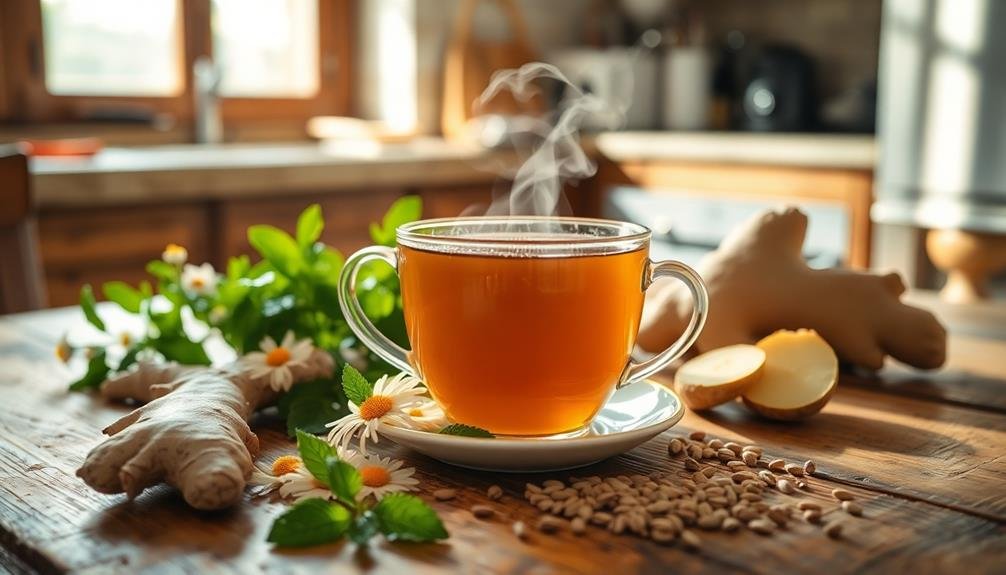
Consistency is key when incorporating DIY digestive tea into your daily routine. To maximize its benefits, aim to drink your homemade blend at least once a day, preferably at the same time. Many find it helpful to consume the tea about 30 minutes before meals to stimulate digestion and prepare the stomach for food.
Create a ritual around your tea-drinking experience to make it more enjoyable and memorable. This can help you maintain the habit long-term. Consider the following ideas:
- Set up a cozy tea corner in your home with comfortable seating and pleasant lighting
- Use a special mug or teacup that you reserve just for your digestive tea
- Play soothing music or practice mindfulness while sipping your tea
- Keep a journal to track your digestive health improvements over time
If you're often on the go, prepare a thermos of your DIY digestive tea in the morning to take with you. This guarantees you'll have it available throughout the day.
Frequently Asked Questions
Can Digestive Tea Help With Specific Conditions Like IBS or Acid Reflux?
Yes, digestive tea can help with IBS and acid reflux. You'll find certain herbs like peppermint and ginger may soothe your symptoms. However, it's not a cure-all, so consult your doctor for severe or persistent issues.
Is It Safe to Drink Digestive Tea While Pregnant or Breastfeeding?
While pregnant or breastfeeding, you should consult your healthcare provider before drinking digestive tea. Some herbs can affect your baby or pregnancy. It's best to err on the side of caution and get professional advice first.
How Long Does It Take to See Results From Drinking Digestive Tea?
You'll typically notice results from digestive tea within 30 minutes to a few hours. It depends on your body and the tea's ingredients. For long-term benefits, you'd need to drink it regularly for several weeks.
Can Children Drink Digestive Tea, and if So, at What Age?
You can give children digestive tea, but it's best to wait until they're at least 4-5 years old. Always consult your pediatrician first, use mild herbs, and serve it lukewarm. Monitor their reaction and adjust accordingly.
Are There Any Medications That Interact Negatively With Digestive Tea Ingredients?
You should be cautious when mixing digestive tea with medications. Some herbs can interact with blood thinners, antidepressants, and other drugs. Always consult your doctor or pharmacist before combining teas with your prescribed medications.
In Summary
You've now got the knowledge to brew your own digestive tea. Remember, it's not just a drink—it's a natural remedy. Start with small batches, experiment with herbs, and listen to your body. Don't forget to consult a healthcare professional if you have concerns. With practice, you'll create the perfect blend for your needs. Embrace this soothing ritual and make it part of your daily wellness routine. Happy brewing!


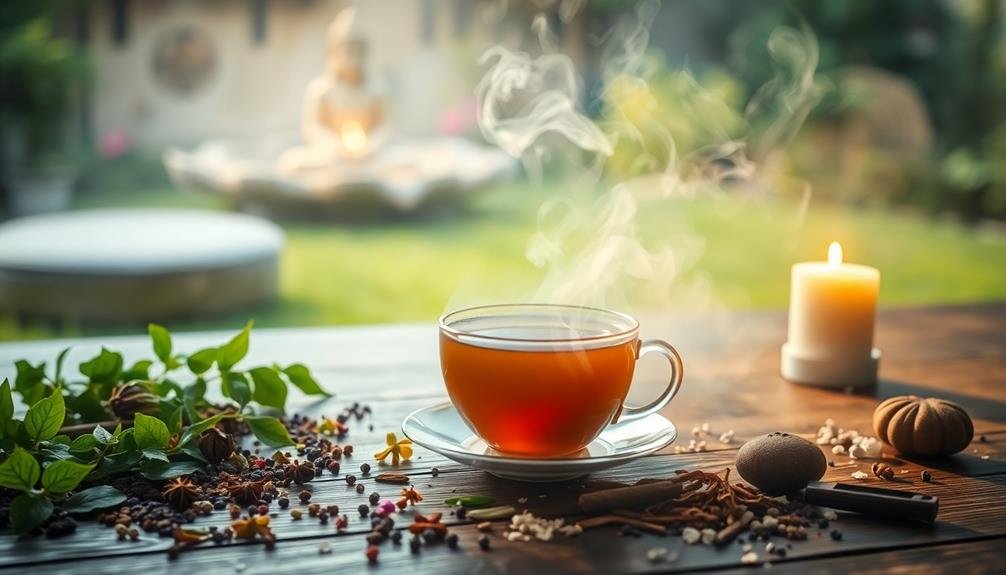
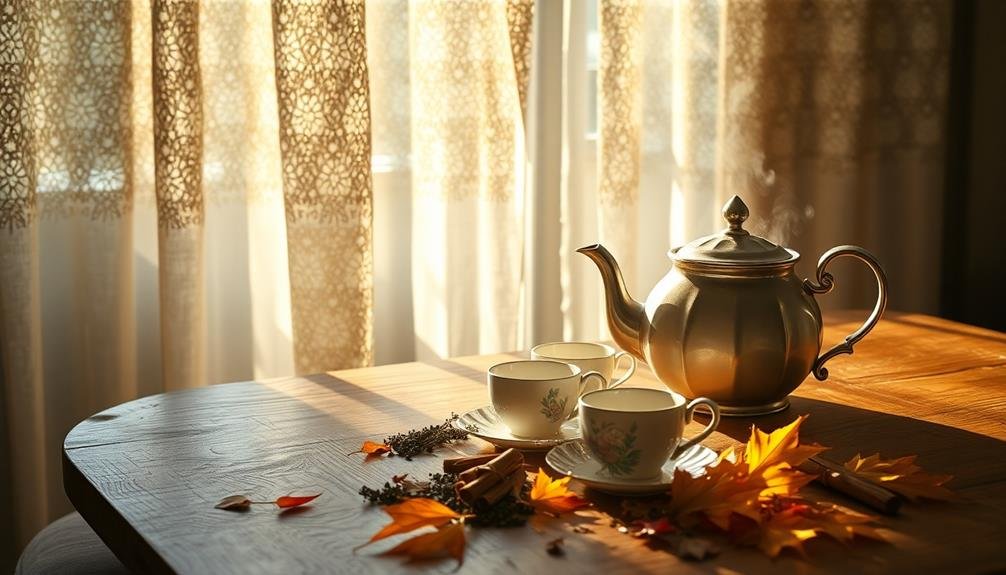
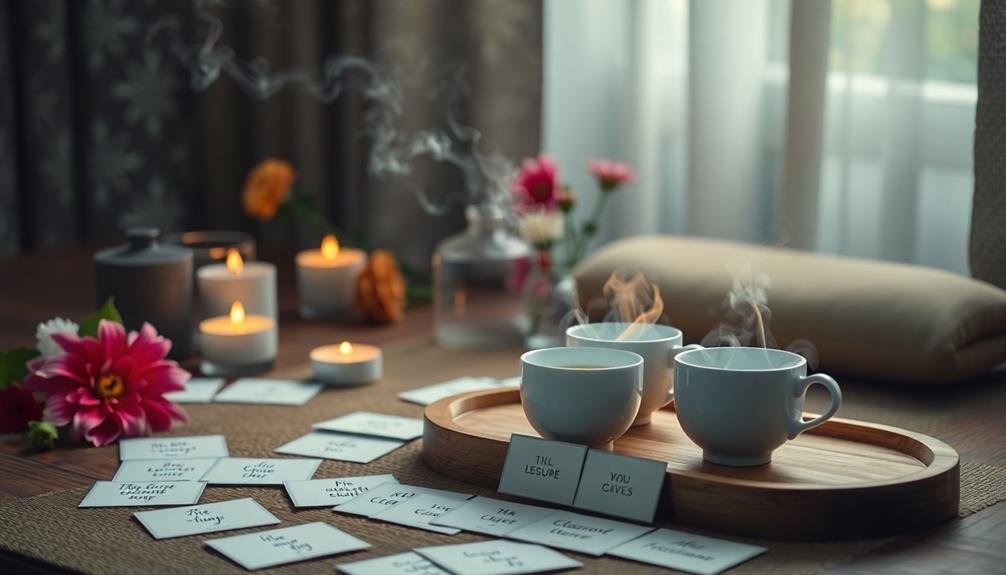
Leave a Reply